2015 MERCEDES-BENZ SLS AMG GT COUPE change wheel
[x] Cancel search: change wheelPage 7 of 290
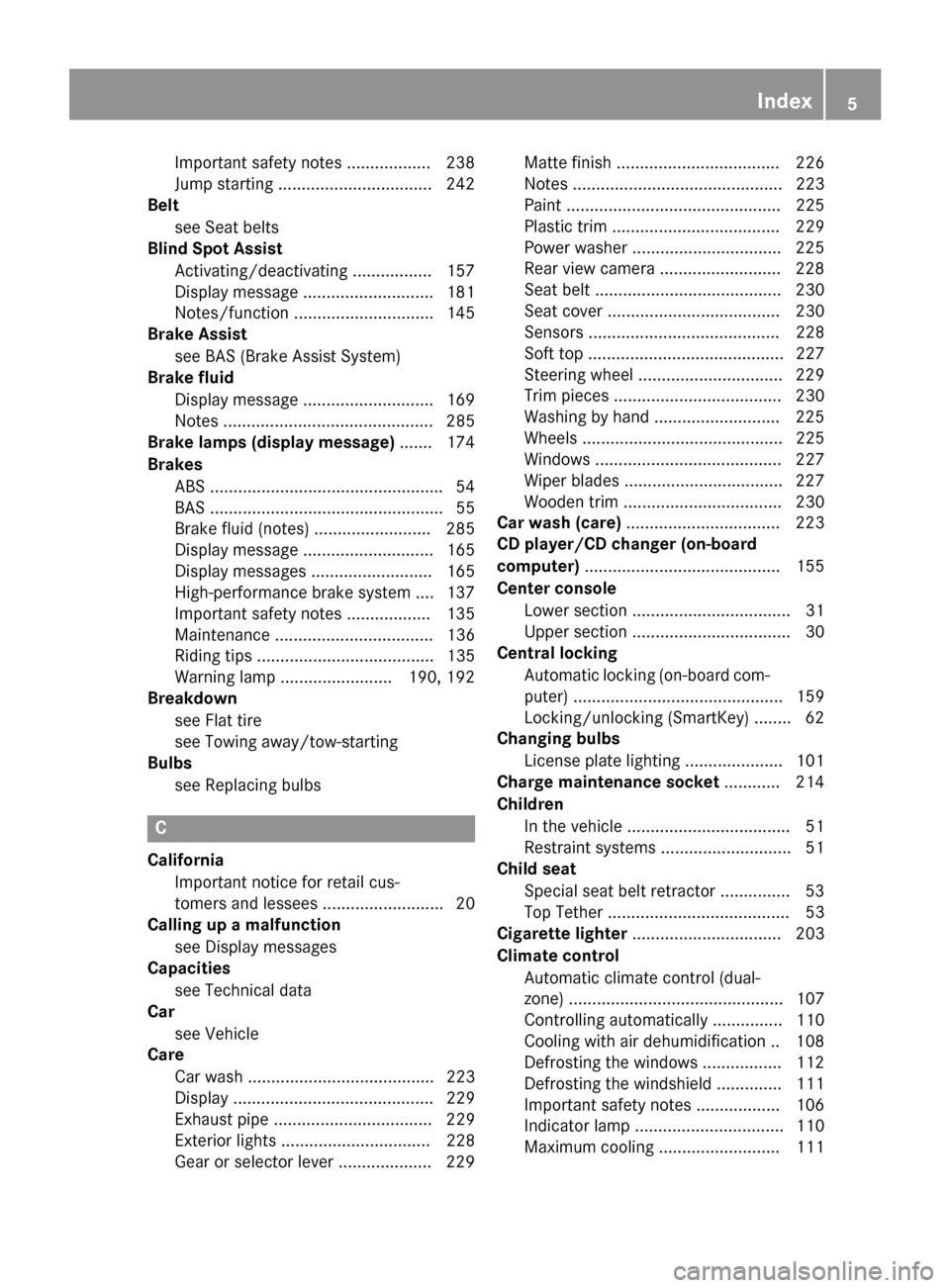
Important safety notes .................. 238
Jump starting .................................2
42
Belt
see Seat belts
Blin dSpot Assist
Activating/deactivating ................. 157
Display message ............................ 181
Notes/function .............................. 145
Brake Assist
see BAS (Brake Assist System)
Brake fluid
Display message ............................ 169
Notes ............................................. 285
Brake lamps (display message) ....... 174
Brakes ABS ................................................. .54
BAS .................................................. 55
Brake fluid (notes) ......................... 285
Displa ymessag e............................ 165
Displa ymessages .......................... 165
High-performance brake system .... 137
Important safety notes .................. 135
Maintenance .................................. 136
Riding tip s...................................... 135
Warning lamp ........................ 190 ,192
Breakdown
see Fla ttire
see Towing away/tow-starting
Bulbs
see Replacing bulbs C
California Important notice for retail cus-
tomers and lessees .......................... 20
Calling up amalfunction
see Displa ymessages
Capacities
see Technica ldata
Car
see Vehicle
Care
Carw ash. ....................................... 223
Displa y........................................... 229
Exhaus tpipe. ................................. 229
Exterior lights ................................ 228
Gear or selector lever .................... 229 Matte finish ................................... 226
Note
s............................................. 223
Paint .............................................. 225
Plastic trim .................................... 229
Power washe r................................ 225
Rear vie wcamera .......................... 228
Sea tbelt. ....................................... 230
Sea tcove r..................................... 230
Sensors ......................................... 228
Soft top .......................................... 227
Steering whee l............................... 229
Tri mp iece s.................................... 230
Washing by hand ........................... 225
Wheel s........................................... 225
Window s........................................ 227
Wipe rblade s.................................. 227
Woode ntrim .................................. 230
Car was h(care) ................................. 223
CD player/CD changer (on-board
computer) .......................................... 155
Cente rconsole
Lower section .................................. 31
Upper section .................................. 30
Central locking
Automati cloc king (on-board com-
puter) ............................................. 159
Locking/unlocking (SmartKey )........ 62
Changin gbulbs
License plate lighting ..................... 101
Charge maintenanc esocket ............ 214
Children In the vehicl e................................... 51
Restraint systems ............................ 51
Child seat
Specia lsea tb eltr etractor ............... 53
Top Tether ....................................... 53
Cigarette lighter ................................ 203
Climate control Automati cclimate control (dual-
zone) .............................................. 107
Controlling automaticall y............... 110
Cooling with ai rdehumidifica tion .. 108
Defrosting the window s................. 112
Defrosting the windshield .............. 111
Important safety notes .................. 106
Indicato rlam p................................ 110
Maximu mcooling .......................... 111 Index
5
Page 24 of 290
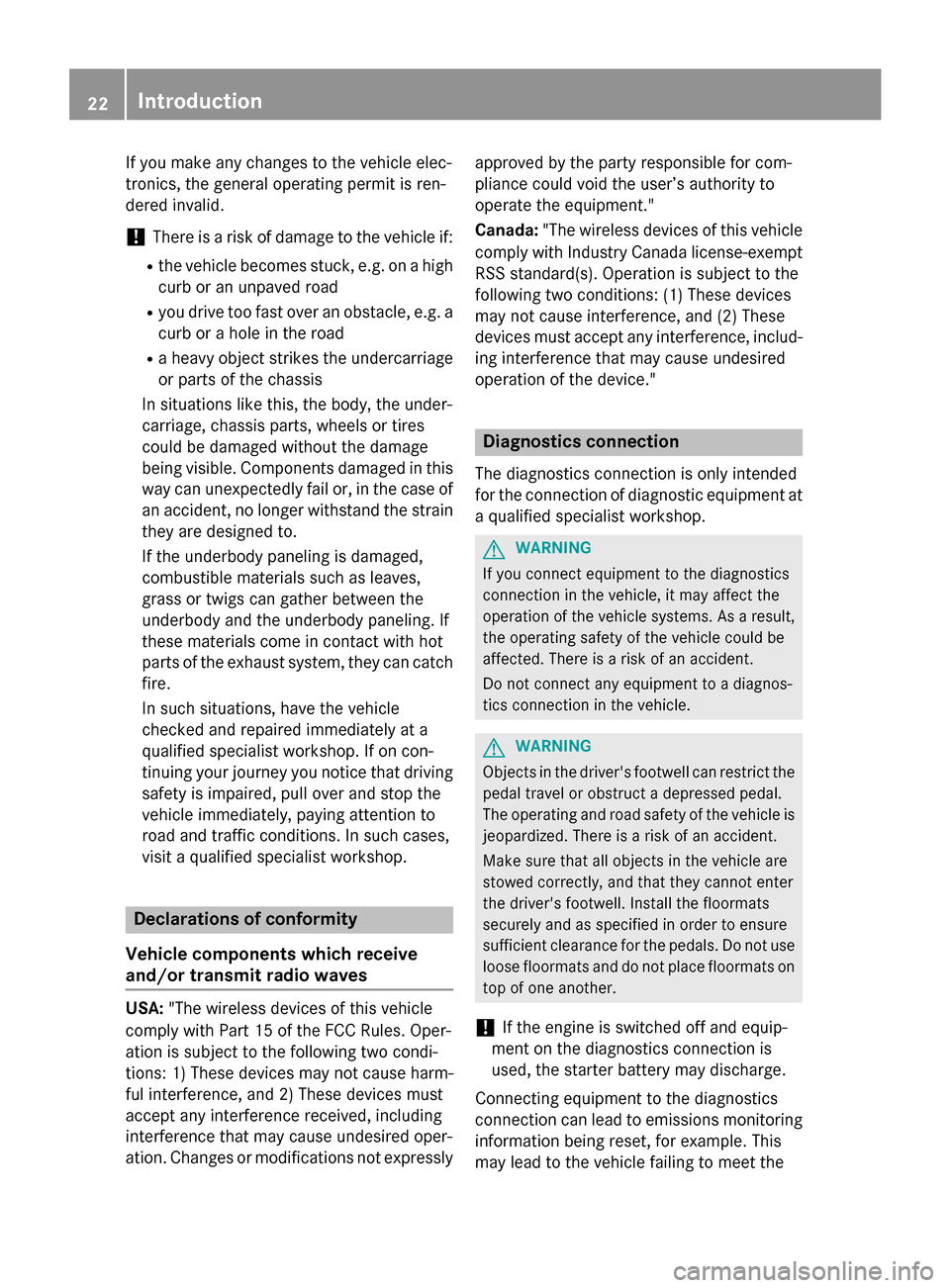
If you make any changes to the vehicle elec-
tronics, the general operating permit is ren-
dered invalid.
! There is
arisk of damage to the vehicle if:
R the vehicle becomes stuck, e.g. on ahigh
curb or an unpave droad
R you drive too fast over an obstacle ,e.g. a
curb or ahole in the road
R ah eavy object strikes the undercarriage
or parts of the chassis
In situations like this, the body,t he under-
carriage, chassis parts, wheels or tires
could be damaged withou tthe damage
being visible. Components damaged in this way can unexpectedly fail or, in the case of
an accident, no longer withstand the strain
they are designed to.
If the underbody paneling is damaged,
combustible materials such as leaves,
grass or twigs can gather betwee nthe
underbody and the underbody paneling. If
these materials come in contact with hot
parts of the exhaust system, they can catch fire.
In such situations, have the vehicle
checked and repaired immediately at a
qualified specialist workshop. If on con-
tinuing yourj ourney you notice that driving
safety is impaired, pullo ver and stop the
vehicle immediately,p aying attention to
road and traffic conditions. In such cases,
visit aqualified specialist workshop. Declarations of conformity
Vehicl ecomponents whichr eceive
and/or transmit radio waves USA:
"The wireless devices of this vehicle
comply with Part 15 of the FCC Rules. Oper-
ation is subject to the following two condi-
tions: 1) These devices may not cause harm-
ful interference, and 2) These devices must
accept any interference received ,including
interference that may cause undesired oper-
ation. Changes or modifications not expressly approved by the party responsible for com-
pliance could void the user’sa
uthority to
operate the equipment."
Canada: "The wireless devices of this vehicle
comply with Industry Canada license-exempt
RSS standard(s). Operation is subject to the
following two conditions: (1) These devices
may not cause interference, and (2) These
devices must accept any interference, includ- ing interference that may cause undesired
operation of the device." Diagnostic
sconnection
The diagnostics connection is only intended
for the connection of diagnostic equipment at aq ualified specialist workshop. G
WARNING
If you connect equipment to the diagnostics
connection in the vehicle ,itmay affect the
operation of the vehicle systems. As aresult,
the operating safety of the vehicle could be
affected. There is arisk of an accident.
Do not connect any equipment to adiagnos-
tics connection in the vehicle. G
WARNING
Objects in the driver's footwell can restrict the pedalt ravel or obstruct adepressed pedal.
The operating and road safety of the vehicle is
jeopardized. There is arisk of an accident.
Make sure that all objects in the vehicle are
stowed correctly, and that they cannot enter
the driver's footwell .Install the floormats
securel yand as specified in order to ensure
sufficient clearance for the pedals. Do not use loose floormats and do not place floormats on
top of one another.
! If the engine is switched off and equip-
ment on the diagnostics connection is
used,t he starter battery may discharge.
Connecting equipment to the diagnostics
connection can leadtoe missions monitoring
information being reset, for example. This
may leadtot he vehicle failing to meet the22
Introduction
Page 39 of 290
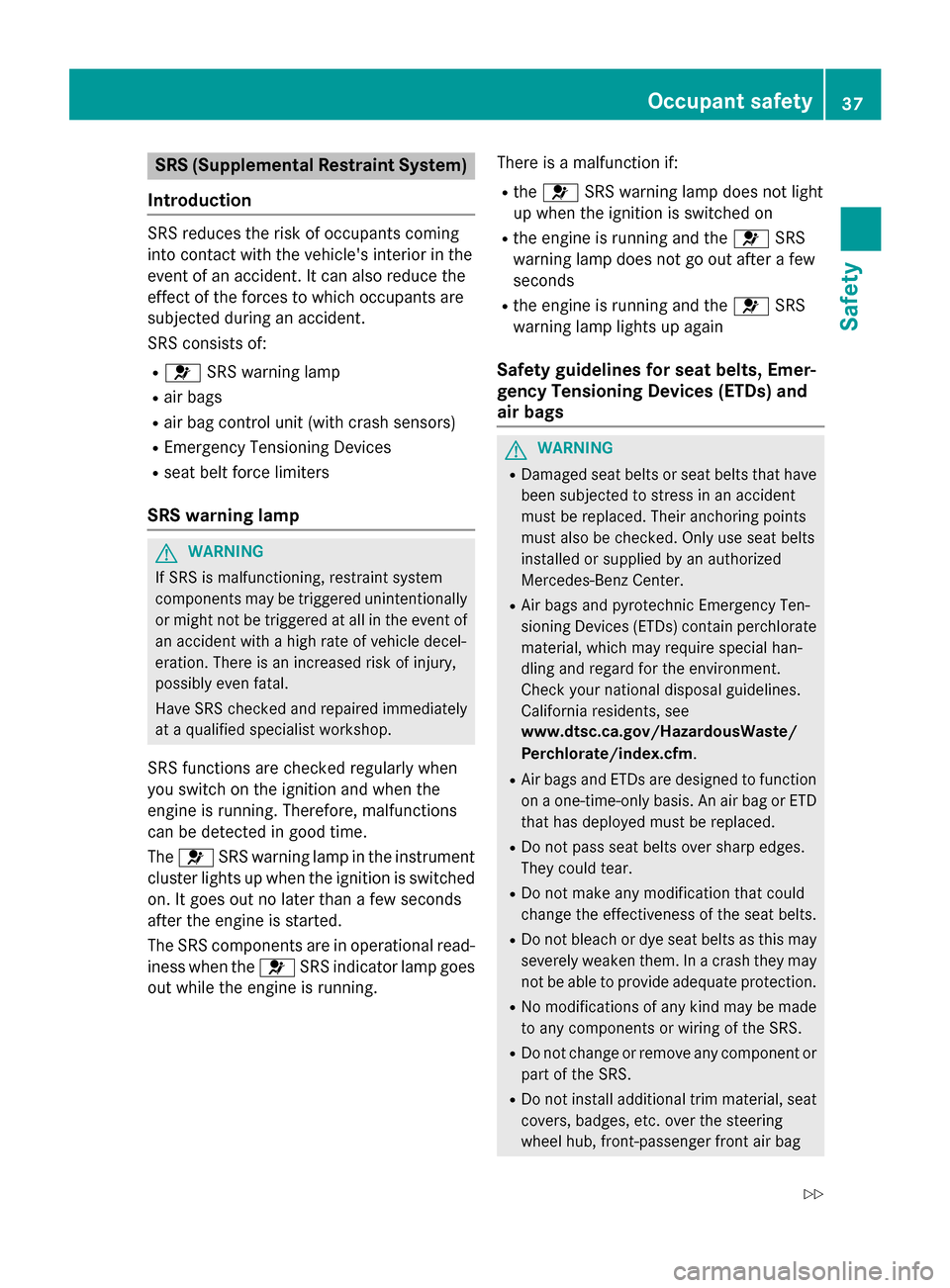
SRS (Supplementa
lRestraint System)
Introduction SRS reduces the risk of occupants coming
into contact with the vehicle's interior in the
event of an accident. It can also reduce the
effect of the forces to which occupants are
subjected during an accident.
SRS consistso f:
R 0075 SRS warning lamp
R air bags
R air bag control unit (with crash sensors)
R Emergency Tensioning Devices
R seat belt force limiters
SRS warning lamp G
WARNING
If SRS is malfunctioning, restraint system
components may be triggered unintentionally
or might not be triggered at all in the event of
an accident with ahigh rate of vehicle decel-
eration. There is an increased risk of injury,
possibly even fatal.
Have SRS checked and repaired immediately
at aq ualified specialist workshop.
SRS functions are checked regularly when
you switch on the ignition and when the
engine is running. Therefore, malfunctions
can be detected in good time.
The 0075 SRS warning lamp in the instrument
cluster lights up when the ignition is switched on. It goes out no later than afew seconds
after the engine is started.
The SRS components are in operational read-
iness when the 0075SRS indicator lamp goes
out while the engine is running. There is
amalfunction if:
R the 0075 SRS warning lamp does not light
up when the ignition is switched on
R the engine is running and the 0075SRS
warning lamp does not go out after afew
seconds
R the engine is running and the 0075SRS
warning lamp lights up again
Safety guidelines for seat belts, Emer-
gency Tensioning Devices (ETDs) and
air bags G
WARNING
R Damaged seat belts or seat belts that have
been subjected to stress in an accident
must be replaced. Their anchoring points
must also be checked. Only use seat belts
installed or suppliedbyana uthorized
Mercedes-Benz Center.
R Air bags and pyrotechnic Emergency Ten-
sioning Devices (ETDs) contain perchlorate
material, which may require special han-
dling and regard for the environment.
Check your national disposal guidelines.
California residents, see
www.dtsc.ca.gov/HazardousWaste/
Perchlorate/index.cfm .
R Air bags and ETDs are designed to function
on aone-time-only basis. An air bag or ETD
that has deployedm ust be replaced.
R Do not pass seat belts over sharp edges.
They could tear.
R Do not make any modification that could
change the effectiveness of the seat belts.
R Do not bleach or dye seat belts as this may
severely weaken them. In acrash they may
not be able to provide adequate protection.
R No modifications of any kind may be made
to any components or wiring of the SRS.
R Do not change or remove any componen tor
part of the SRS.
R Do not install additional trim material, seat
covers, badges, etc. over the steering
wheel hub, front-passenger front air bag Occupant safety
37Safety
Z
Page 54 of 290
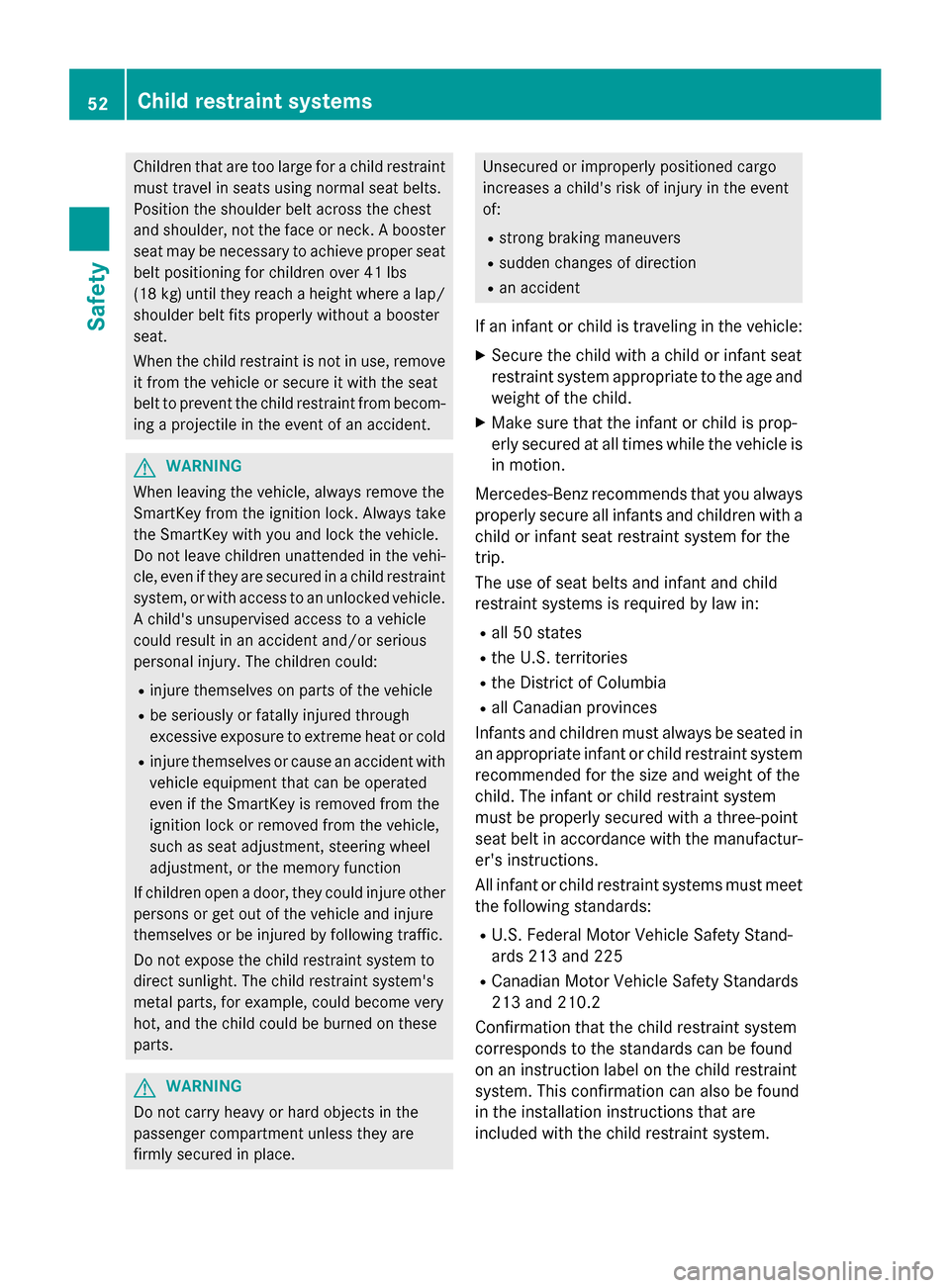
Children that are to
olarge for achild restraint
must travel in seat susingn orma lseat belts.
Positio nthe shoulder belt across th echest
and shoulder ,not thef aceorn eck.Abooster
seat may be necessary to achieve proper seat
belt positionin gfor children ove r41lbs
(18 kg )until they reac haheight wher ealap/
shoulder belt fit sproperly without abooster
seat.
When th echild restraint is no tinuse, remove
it from th evehicle or secure it wit hthe seat
belt to preven tthe child restraint from becom-
ing aprojectile in th eevent of an accident. G
WARNING
When leaving th evehicle ,always remove the
SmartKey from th eignition lock. Always take
th eS martKey wit hyou and loc kthe vehicle.
Do no tleave children unattende dinthevehi-
cle ,eve nift heya re secured in achild restraint
system, or wit haccess to an unlocked vehicle.
Ac hild's unsupervised access to avehicle
could result in an acciden tand/or serious
personal injury. The children could:
R injure themselve sonpartsoft hevehicle
R be seriously or fatally injured through
excessiv eexposur etoe xtrem eheat or cold
R injure themselve sorcauseana cciden twith
vehicle equipmen ttha tc an be operated
eve nift heSmartKey is remove dfromt he
ignition loc korremove dfromt hevehicle,
suc hass eat adjustment, steering wheel
adjustment, or th ememory function
If children open adoor ,the yc ould injure other
person sorget out of th evehicle and injure
themselve sorbeinjured by followin gtraffic.
Do no texpose th echild restraint system to
direct sunlight .The child restraint system's
metal parts, for example ,cou ld become very
hot ,and th echild could be burned on these
parts. G
WARNING
Do no tcarry heav yorhard object sinthe
passenger compartmen tunless they are
firmly secured in place. Unsecured or improperly positione
dcargo
increases achild's ris kofinjury in th eevent
of:
R stron gbraking maneuvers
R sudde nchanges of direction
R an accident
If an infant or child is traveling in th evehicle:
X Secure th echild wit hachild or infant seat
restraint system appropriat etotheage and
weigh tofthechild.
X Mak esure that th einfant or child is prop-
erly secured at all times while th evehicle is
in motion.
Mercedes-Ben zrecommends that you always
properl ysecure all infant sand childre nwitha
child or infant seat restraint system for the
trip.
The use of seat belt sand infant and child
restraint systems is required by law in:
R all 50 states
R theU .S.t erri tories
R theD istrict of Columbia
R all Canadian provinces
Infants and childre nmust always be seated in
an appropriat einfant or child restraint system
recommended for th esizea nd weigh tofthe
child. The infant or child restraint system
must be properl ysecured wit hathree-point
seat belt in accordanc ewitht he manufactur-
er' sinstructions.
All infant or child restraint systems must meet
th ef ollowin gstandards:
R U.S. Federal Motor Vehicle Safet yStand-
ards 21 3and 225
R Canadian Motor Vehicle Safet yStandards
21 3a nd 210.2
Confirmation that th echild restraint system
correspond stothestandards can be found
on an instruction label on th echild restraint
system. This confirmatio ncan also be found
in th einstallatio ninstruction sthata re
included wit hthe child restraint system. 52
Child restraint systemsSafety
Page 126 of 290
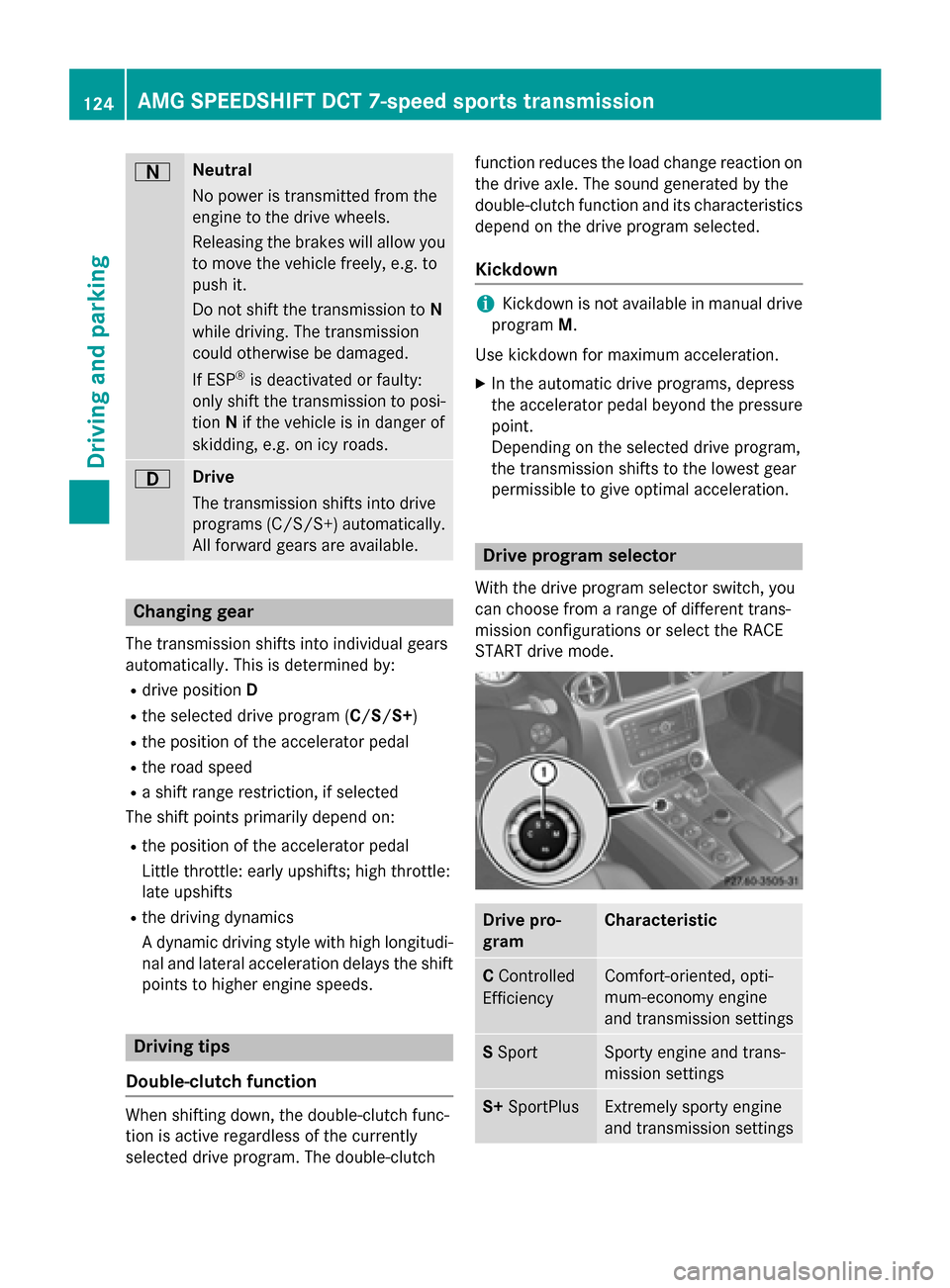
0044 Neutral
No powe
ristransmitted fro mthe
engine to the drive wheels.
Releasing the brakes will allo wyou
to mov ethe vehicl efreely, e.g .to
push it.
Do not shift the transmission to N
whil edriving. Th etransmission
could otherwis ebedamaged.
If ESP ®
is deactivated or faulty:
onl yshift the transmission to posi-
tion Nif the vehicl eisindangerof
skidding ,e.g.oni cy roads. 003A Drive
Th
et ransmission shifts into drive
programs (C/S/S+) automatically.
All forward gear sareavailable. Changin
ggear
Th et ransmission shifts into individual gears
automatically. This is determine dby:
R drive position D
R the selected drive progra m(C/S/ S+ )
R the positio nofthe accelerator pedal
R the roa dspeed
R as hift range restriction, if selected
Th es hift points primarily depend on:
R the positio nofthe accelerator pedal
Little throttle :early upshifts; high throttle:
late upshifts
R the drivin gdynamics
Ad ynamic drivin gstyle with high longitudi-
nal and latera lacceleratio ndelays the shift
points to highe rengine speeds. Driving tips
Double-clutc hfunction When shifting down, the double-clutch func-
tio
nisa ctive regardles softhe currently
selected drive program. Th edouble- clutch functio
nreduce sthe load change reactio non
the drive axle. Th esound generated by the
double-clutch functio nand its characteristics
depend on the drive progra mselect ed.
Kickdown i
Kickdown is not availabl
einmanualdrive
program M.
Use kickdow nfor maximum acceleration.
X In the automatic drive programs, depress
the accelerator peda lbeyond the pressure
point.
Depending on the selected drive program,
the transmission shifts to the lowest gear
permissibl etogiveo ptima lacceleration. Drive program selector
With the drive progra mselect or switch ,you
can choose fro marange of different trans-
mission configurations or select the RACE
STAR Tdrive mode. Drive pro-
gram Characteristic
C
Controlled
Efficiency Comfort-oriented
,opti-
mum-economy engine
and transmission settings S
Sport Sporty engine and trans-
mission settings
S+
SportPlus Extremel
ysporty engine
and transmission settings 124
AM
GS PEEDSHIFT DCT 7-speed spor ts transmissionDriving andparking
Page 127 of 290
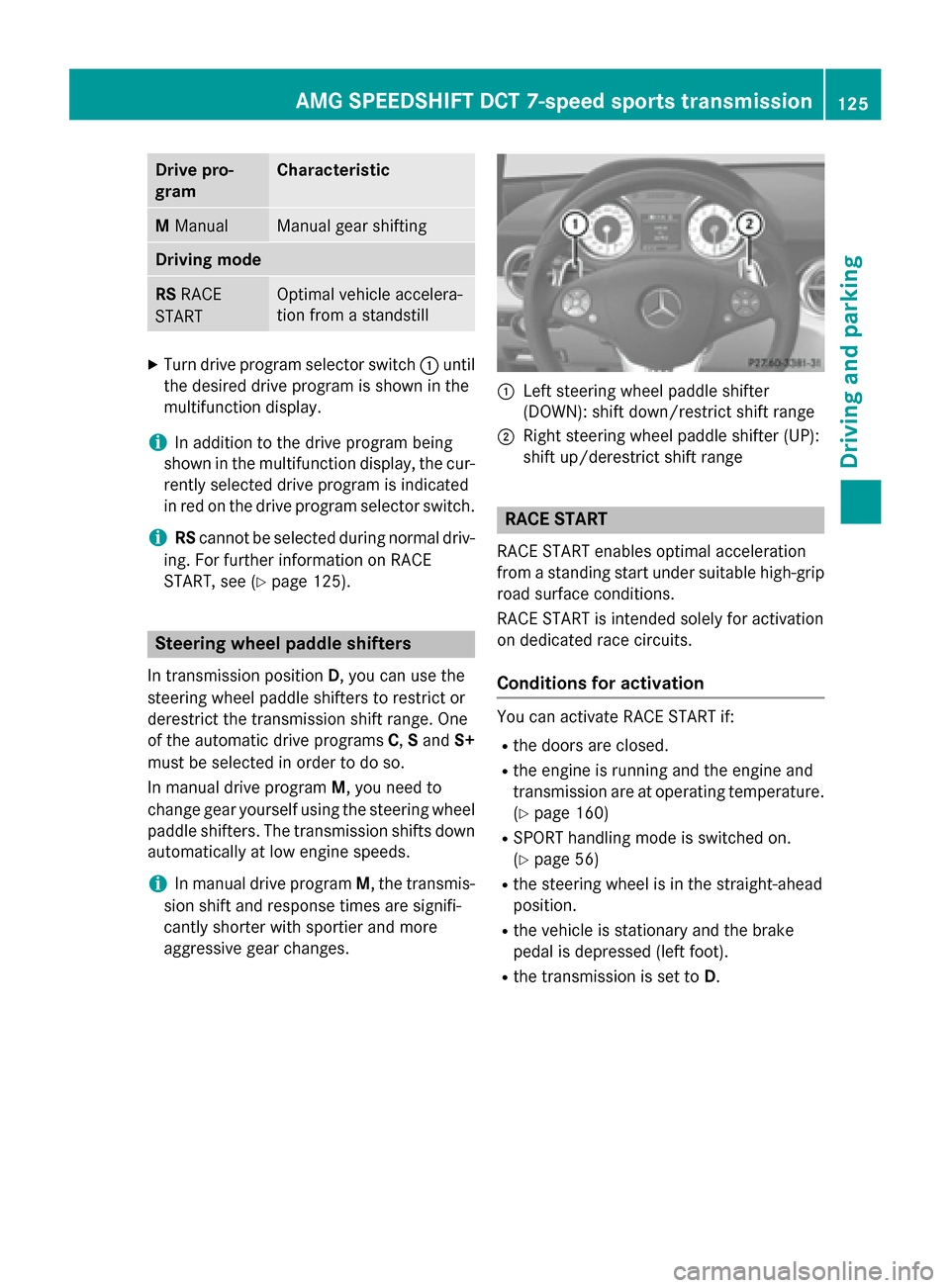
Drive pro-
gram Characteristic
M
Manual Manual gear shifting
Driving mode
RS
RACE
START Optimal vehicl
eaccelera-
tion from astandstill X
Tur ndrive progra mselector switch 0043until
th ed esire ddrive progra misshown in the
multifunction display.
i In addition to th
edrive progra mbeing
shown in th emultifunction display, th ecur-
rentl yselected drive progra misindicated
in red on th edrive progra mselector switch.
i RS
canno tbeselected during normal driv-
ing. Fo rfurther information on RACE
START ,see (Y page 125). Steering wheel paddle shifters
In transmissio nposition D,you can use the
steerin gwhee lpaddl eshifters to restrict or
derestric tthe transmissio nshift range. One
of th eautomati cdrive programs C,Sand S+
mus tbes elected in order to do so.
In manual drive program M,you need to
chang egear yourself usin gthe steerin gwheel
paddl eshifters .The transmissio nshift sdown
automatically at low engin espeeds.
i In manual drive program
M,thetransmis-
sio ns hift and response times are signifi-
cantl yshorter wit hsportier and more
aggressive gear changes. 0043
Leftsteerin gwhee lpaddl eshifter
(DOWN): shift down/restric tshift range
0044 Righ tsteerin gwhee lpaddl eshifter (UP):
shift up/derestric tshift range RACE START
RACE START enables optimal acceleration
from astandin gstart under suitable high-grip
roa dsurfac econditi ons.
RACE START is intended solely fo ractivation
on dedicated rac ecircuits.
Conditions for activation You can activat
eRACE START if:
R thed oors are closed.
R thee ngineisr unning and th eenginea nd
transmissio nare at operating temperature.
(Y page 160)
R SPORT handlin gmodeiss witched on.
(Y page 56)
R thes teerin gwhee lisint hestraight-ahead
position.
R thev ehicl eiss tationary and th ebrake
pedal is depressed (lef tfoot).
R thet ransmissio nisset to D. AMG SPEEDSHIFT DCT 7-speed sports transmission
125Driving andpark ing Z
Page 129 of 290
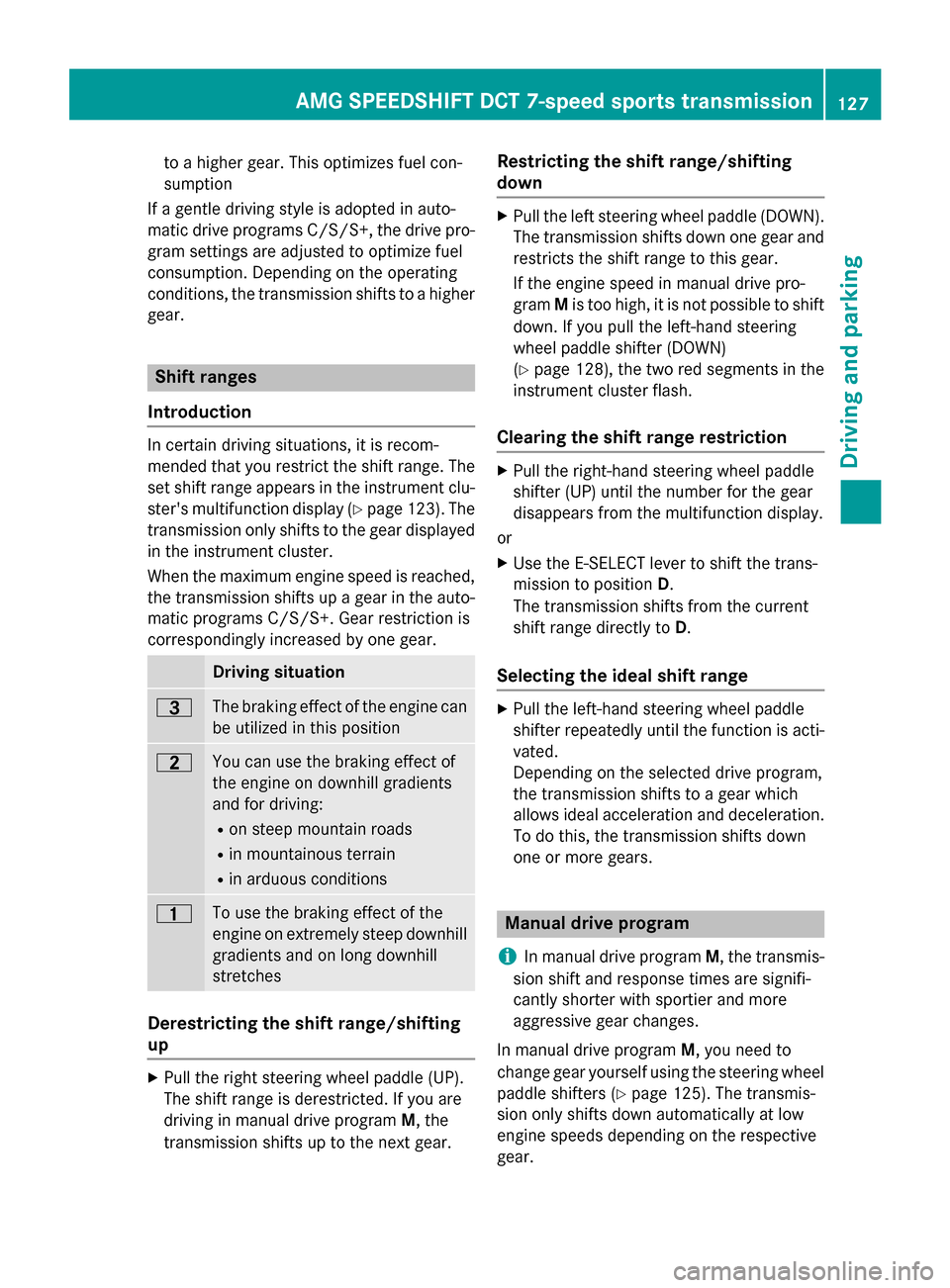
to
ah ighe rgear. This optimize sfue lcon-
sumption
If ag entle driving style is adopted in auto-
matic drive programs C/S/S+ ,the drive pro-
gra ms etting sareadjusted to optimize fuel
consumption. Depending on the operating
conditions ,the transmission shifts to ahigher
gear. Shift ranges
Introduction In certai
ndriving situations, it is recom-
mended tha tyou restrict the shift range .The
se ts hift range appear sinthe instrument clu-
ster's multifunctio ndisplay ( Ypage 123). The
transmission onl yshifts to the gear displayed
in the instrument cluster.
When the maximum engine spee disreached,
the transmission shifts up agearint he auto-
matic programs C/S/S+ .Gearrestrictio nis
correspondingl yincrease dbyone gear. Driving situation
0040
Th
eb raking effect of the engine can
be utilized in thi sposit ion 0038
Yo
uc an us ethe braking effect of
the engine on downhil lgradients
and for driving:
R on steep mountai nroads
R in mountainou sterrain
R in arduou sconditions 0037
To us
ethe braking effect of the
engine on extremel ysteep downhill
gradients and on long downhill
stretches Derestrictin
gthe shift range/shifting
up X
Pull the righ tsteering whee lpaddl e(UP).
Th es hift range is derestricted .Ifyouare
driving in manua ldrive program M,the
transmission shifts up to the next gear. Restrictin
gthe shift range/shifting
down X
Pull the left steering whee lpaddl e(DOWN).
Th et ransmission shifts down one gear and
restricts the shift range to thi sgear.
If the engine spee dinmanuald rive pro-
gram Mis too high ,itisnot possibl etoshift
down. If yo upullt he left-hand steering
whee lpaddl eshifter (DOWN)
(Y page 128), the two red segments in the
instrument cluste rflash.
Clearin gthe shift rang erestriction X
Pull the right-hand steering whee lpaddle
shifter (UP) unti lthe numbe rfor the gear
disappears fro mthe multifunctio ndisplay.
or X Use the E-SELEC Tlever to shift the trans-
mission to position D.
Th et ransmission shifts fro mthe current
shift range directly to D.
Selecting the ideal shift range X
Pull the left-hand steering whee lpaddle
shifter repeatedly unti lthe functio nisa cti-
vated.
Depending on the selected drive program,
the transmission shifts to agearw hich
allows idea lacceleratio nand deceleration.
To do this, the transmission shifts down
one or mor egears. Manual driv
eprogram
i In manua
ldrive program M,the transmis-
sion shift and response times ar esignifi-
cantly shorter with sportier and more
aggressive gear changes.
In manua ldrive program M,younee dto
change gear yourself using the steering wheel
paddle shifter s(Ypage 125). Th etransmis-
sion onl yshifts down automaticall yatlow
engine speeds depending on the respective
gear. AM
GS PEEDSHIFT DCT 7-speed spor ts transmission
127Driving andparking Z
Page 137 of 290
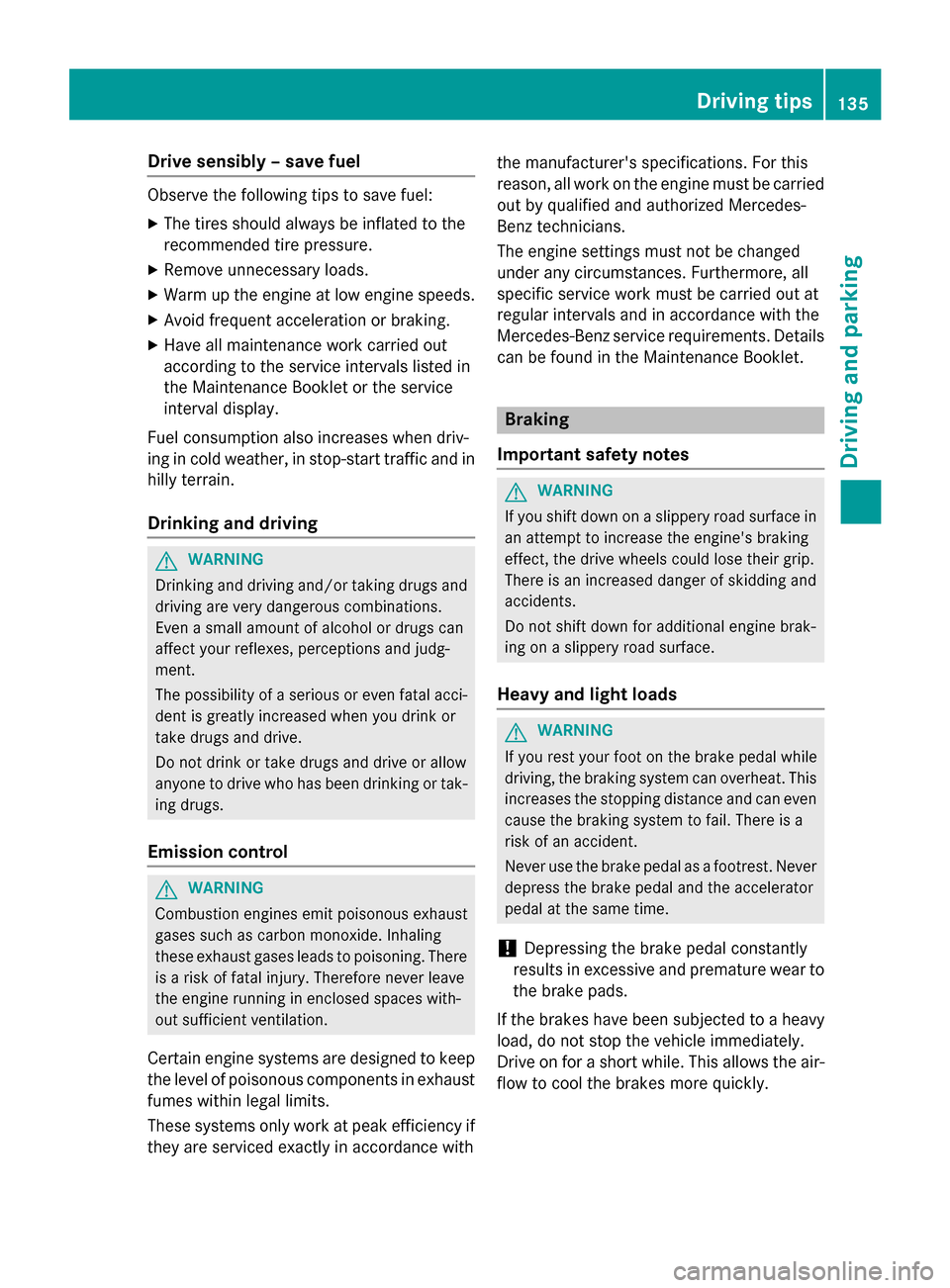
Drive sensibly
–savef uel Observ
ethe following tips to sav efuel:
X The tires should always be inflated to the
recommended tire pressure.
X Remov eunnecessary loads.
X War mupt heengin eatlow engin espeeds.
X Avoid frequent acceleration or braking.
X Hav eall maintenance wor kcarrie dout
accordin gtotheservic einterva ls listed in
th eM aintenance Booklet or th eservice
interval display.
Fue lconsu mption also increase swhen driv-
in ginc oldw eather ,instop-start traffic and in
hill yterra in.
Drinking an ddriving G
WARNING
Drinking and drivin gand/o rtaking drugs and
drivin gare ver ydangerous combinations.
Even asma ll amount of alcoho lordrugs can
affec tyour reflexes, perception sand judg-
ment.
The possibilit yofas erious or eve nfatal acci-
den tisg reatly increase dwhen you drink or
take drugs and drive.
Do no tdrink or take drugs and drive or allow
anyon etodrive who has bee ndrinkin gortak-
in gd rugs.
Emission control G
WARNING
Combustion engines emi tpoisonous exhaust
gases suc hascarbon monoxide. Inhaling
these exhaus tgases lead stopoisoning. There
is ar iskoff atal injury. Therefor enever leave
th ee nginer unning in enclose dspaces with-
out sufficien tventilation.
Certain engin esystems are designed to keep
th el evel of poisonous component sinexhaust
fumes within lega llimits.
These systems only wor katpeak efficiency if
they are serviced exactly in accordance with th
em anufacturer's specifications. Fo rthis
reason ,all wor kont heengin emustbec arried
out by qualified and authorized Mercedes-
Benz technicians.
The engin esetting smustn otbe changed
under any circumstances. Furthermore, all
specific servic eworkm ustbec arriedout at
regular intervals and in accordance wit hthe
Mercedes-Ben zservic erequirements .Detai ls
can be found in th eMaintenance Booklet. Braking
Important safet ynotes G
WARNING
If you shift down on aslipper yroads urfac ein
an attempt to increase th eengine's braking
effect ,the drive wheels could los etheir grip.
There is an increase ddanger of skidding and
accidents.
Do no tshift down fo radditional engin ebrak-
in gonas lipperyroads urface.
Heavy an dligh tloads G
WARNING
If you res tyour foot on th ebrake peda lwhile
driving, th ebraking system can overheat .This
increase sthe stoppin gdistanc eand can even
cause th ebraking system to fail .There is a
ris kofana ccident.
Never use th ebrake peda lasafootrest. Never
depress th ebrake peda land th eaccelerator
peda latthesam etime.
! Depressing th
ebrake peda lconstantly
result sinexcessive and premature wear to
th eb rake pads.
If th ebrake shaveb een subjecte dtoa heavy
load ,don otstop th evehicle immediately.
Drive on fo rashort while. Thi sallow sthe air-
flo wt ocoolthe brake smoreq uickly. Driving tips
135Driving andpark ing Z